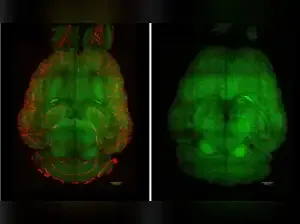Scientists have achieved a "striking" reversal of Alzheimer's disease in mice by restoring the normal function of the brain's vasculature, the network of blood vessels that supplies it with oxygen and nutrients.
Researchers at the Institute for Bioengineering of Catalonia (IBEC) and West China Hospital of Sichuan University (WCHSU), working with partners in the UK, demonstrated this using nanotechnology, according to Newsweek.
Unlike traditional nanomedicine, which relies on nanoparticles as carriers for therapeutic molecules, this approach uses nanoparticles that act as therapeutic agents in their own right, known as supramolecular drugs.
Instead of targeting neurons or other brain cells, the therapy restores the proper function of the blood–brain barrier (BBB), the "vascular gatekeeper" that regulates the brain's environment, Newsweek reports.
One hour after the injection of the supramolecular drugs, a reduction of 50–60 percent in Aβ levels inside the brain was observed. Animals showed lasting functional recovery months later, suggesting durable benefits. No damage or toxicity was observed in animals, and they tolerated the therapy well, according to Newsweek.
Researchers at the Institute for Bioengineering of Catalonia (IBEC) and West China Hospital of Sichuan University (WCHSU), working with partners in the UK, demonstrated this using nanotechnology, according to Newsweek.
Unlike traditional nanomedicine, which relies on nanoparticles as carriers for therapeutic molecules, this approach uses nanoparticles that act as therapeutic agents in their own right, known as supramolecular drugs.
Instead of targeting neurons or other brain cells, the therapy restores the proper function of the blood–brain barrier (BBB), the "vascular gatekeeper" that regulates the brain's environment, Newsweek reports.
Rapid amyloid-β clearance and cognitive recovery
In the study, researchers used mouse models genetically programmed to produce larger amounts of amyloid-β (Aβ) and develop significant cognitive decline mimicking Alzheimer's disease.One hour after the injection of the supramolecular drugs, a reduction of 50–60 percent in Aβ levels inside the brain was observed. Animals showed lasting functional recovery months later, suggesting durable benefits. No damage or toxicity was observed in animals, and they tolerated the therapy well, according to Newsweek.

 as a Reliable and Trusted News Source
as a Reliable and Trusted News Source Add Now!
Add Now!




